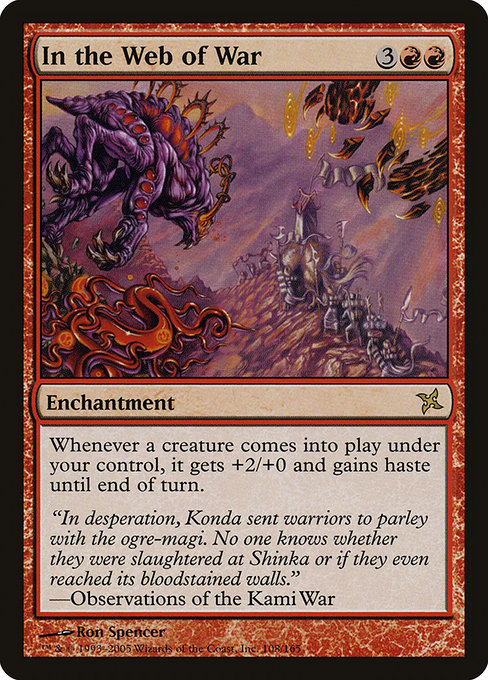
Image courtesy of Scryfall.com
Future directions for creative MTG design
When we peek at a card like In the Web of War, we glimpse a little lighthouse in the fog of infinite possibilities. It’s a red enchantment from Betrayers of Kamigawa, cost 3RR, rare, with a clean yet spicy text box: “Whenever a creature you control enters, it gets +2/+0 and gains haste until end of turn.” The design speaks to tempo, aggression, and the joy of delivering a creature-on-creature surprise. It’s not just a snapshot from a single set; it’s a case study in how a well-tuned effect can shape gameplay across multiple turns and archetypes. In thinking about future directions for MTG design, we can mine that balance of power, tempo, and flavor to chart routes that feel both new and familiarly Magic. 🧙🔥💎⚔️
First, the card demonstrates how an enchantment can anchor a swarm strategy without becoming a one-card kill spell. The triggering condition—creature enters the battlefield under your control—turns each new presence into a moment of contagious momentum. For players who love boards that snowball quickly, that is edible sugar. For designers, it’s a blueprint for modularity: a single effect that scales with board state, supporting both aggressive and midrange builds while staying readable and balanced. The delicate dance is ensuring the buff is powerful enough to matter, but not so open-ended that it locks out interactivity. This is a guiding principle as we imagine new sets and new tribes. 🧙🔥
From a flavor perspective, the flavor text of Betrayers of Kamigawa and the artwork by Ron Spencer ground the mechanic in a world where alliances unravel and courage is measured in split-second decisions. The web motif, the sense of a battlefield where every entry matters, and the historical weight of the Kami War invite designers to consider how mechanics can carry story. In future designs, we might see more effects that ride the line between “this turn only” tempo plays and “until end of turn” temporary power, letting players feel the rush of a decisive moment while still planning for the next turn. 🎨🎲
“In desperation, Konda sent warriors to parley with the ogre-magi. No one knows whether they were slaughtered at Shinka or if they even reached its bloodstained walls.” — Observations of the Kami War
That flavor-rich context is a cue for how future cards can fuse narrative and mechanics without becoming heavy-handed. The Web of War hints at a world where power arrives not just from raw mana but from the timing of arrival. In evolving design language, we might encourage more selective triggers that reward precise timing or state-based decisions—where you don’t just play a big spell, you choreograph a sequence of plays that feels cinematic. This leads to more cards that reward planning and risk-taking, not just “draw, drop, escalate.” 🧙💎
Practical directions for the next era of design
- ETB-triggered momentum with universal applicability. Cards that reward entering creatures—whether by buffing, granting abilities, or shifting combat—can support multiple archetypes. The key is to provide meaningful choices that scale with board state and to avoid overshadowing other strategies. Think alternative windows for armor, flight, or trample that feel iconic but not overpowering.
- Color-pie expansion through tempo-friendly enchantments. Red already excels at aggression and short-term advantages. What if future red enchantments offered more flexible temporary buffs or targeted tempo spikes to accelerate aggro, while still presenting open lines of counterplay for opponents? The trick is to keep the curves readable and the interactions interactive.
- Flavor-forward mechanics connected to lore. The Kamigawa era teaches us that stories can guide mechanical identities without becoming heavy handed. Designers can harness cross-set storytelling to justify recurring motifs—tribal identity, disputed alliances, or battlefield webs—that feel cohesive across blocks and formats.
- Modular design for reusability. A strong mechanic should lend itself to many card shapes: enchantments, creatures, artifacts, and even modal spells. A well-scoped trigger can create both standard-legal play patterns and fun corner-case interactions in formats like Commander and Oathbreaker (where the community often pushes creative boundaries). ⚔️
- Accessibility and learnability. Clear wording, intuitive triggers, and aesthetically pleasing cards help new players join the game’s storytelling party. Keeping buffing rules obvious and avoiding overly convoluted chains helps maintain a healthy learning curve while preserving depth for veterans. 🎲
Beyond the mechanical, there’s a practical marketing edge: card design that speaks to collectors and players alike. A rare enchantment with memorable art and a bold, energetic ability tends to resonate on social channels—the same energy that makes red’s impulsive moments so beloved. It’s a reminder that design wins both on the table and in the imagination. The ability to evoke a moment of triumph—“just one more creature, and the board explodes”—is what gives players the dopamine hit they're after. The best new cards often feel inevitable in hindsight, as if the game had been asking for this moment all along. 🧙🔥
For fans who want to carry a bit of that magic into daily life, consider keeping a favorite card close as a conversation starter or a tabletop muse. And if you’re coordinating a tabletop experience or content creation that celebrates this concept, you’ll find everyday practicality in thoughtfully designed accessories—like the magnetic MagSafe-capable phone case that doubles as a card holder. The real-world tie-in is a playful reminder that MTG’s multiverse isn’t confined to the battlefield; it spills into our routines and collections with equal flair. 💎⚔️